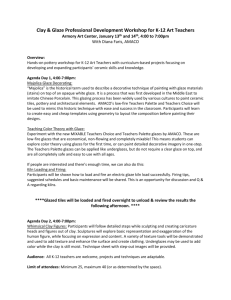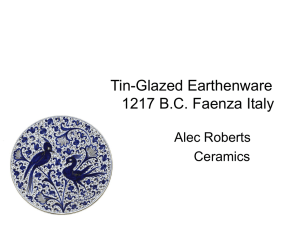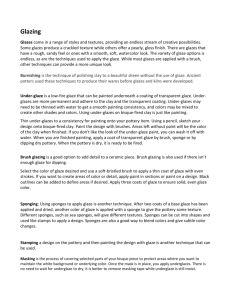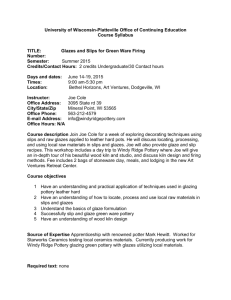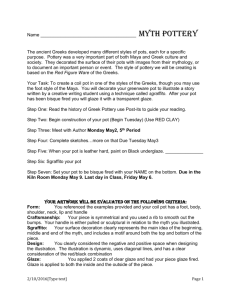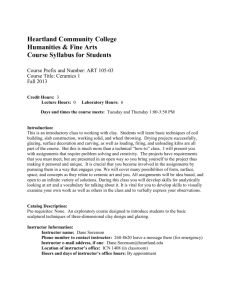Glazing - Expressions Pottery Workshop
advertisement
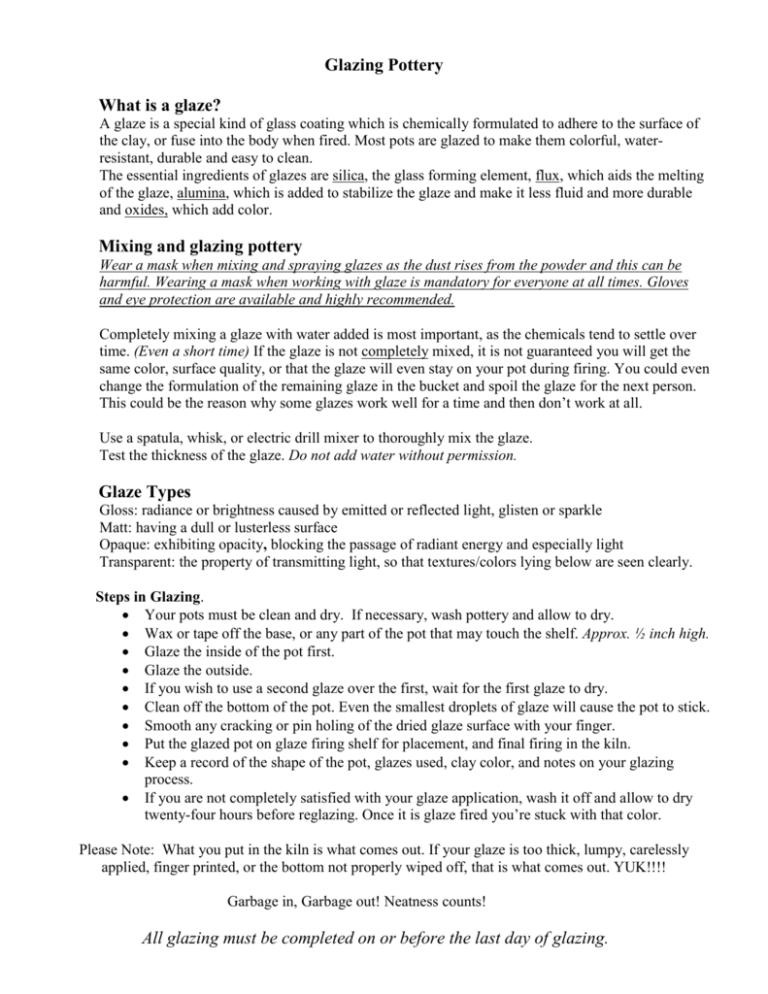
Glazing Pottery What is a glaze? A glaze is a special kind of glass coating which is chemically formulated to adhere to the surface of the clay, or fuse into the body when fired. Most pots are glazed to make them colorful, waterresistant, durable and easy to clean. The essential ingredients of glazes are silica, the glass forming element, flux, which aids the melting of the glaze, alumina, which is added to stabilize the glaze and make it less fluid and more durable and oxides, which add color. Mixing and glazing pottery Wear a mask when mixing and spraying glazes as the dust rises from the powder and this can be harmful. Wearing a mask when working with glaze is mandatory for everyone at all times. Gloves and eye protection are available and highly recommended. Completely mixing a glaze with water added is most important, as the chemicals tend to settle over time. (Even a short time) If the glaze is not completely mixed, it is not guaranteed you will get the same color, surface quality, or that the glaze will even stay on your pot during firing. You could even change the formulation of the remaining glaze in the bucket and spoil the glaze for the next person. This could be the reason why some glazes work well for a time and then don’t work at all. Use a spatula, whisk, or electric drill mixer to thoroughly mix the glaze. Test the thickness of the glaze. Do not add water without permission. Glaze Types Gloss: radiance or brightness caused by emitted or reflected light, glisten or sparkle Matt: having a dull or lusterless surface Opaque: exhibiting opacity, blocking the passage of radiant energy and especially light Transparent: the property of transmitting light, so that textures/colors lying below are seen clearly. Steps in Glazing. Your pots must be clean and dry. If necessary, wash pottery and allow to dry. Wax or tape off the base, or any part of the pot that may touch the shelf. Approx. ½ inch high. Glaze the inside of the pot first. Glaze the outside. If you wish to use a second glaze over the first, wait for the first glaze to dry. Clean off the bottom of the pot. Even the smallest droplets of glaze will cause the pot to stick. Smooth any cracking or pin holing of the dried glaze surface with your finger. Put the glazed pot on glaze firing shelf for placement, and final firing in the kiln. Keep a record of the shape of the pot, glazes used, clay color, and notes on your glazing process. If you are not completely satisfied with your glaze application, wash it off and allow to dry twenty-four hours before reglazing. Once it is glaze fired you’re stuck with that color. Please Note: What you put in the kiln is what comes out. If your glaze is too thick, lumpy, carelessly applied, finger printed, or the bottom not properly wiped off, that is what comes out. YUK!!!! Garbage in, Garbage out! Neatness counts! All glazing must be completed on or before the last day of glazing. Overglazes Painting ceramic colors or glazes over a base glazed pot and fusing them on the ware when fired. When putting a second glaze over the first, wait for the first glaze to dry. Resist Methods Many decorative glaze effects can be achieved by covering sections of a piece with wax-resist or masking off areas with paper, tape or stencils so that base area will remain visible. Oxide Washes Always mix with gloves, mask and eye protection. Students should ask a member to mix if supply is depleted. All glazes with high percentages of oxides are toxic when used as food containers. Oxide Washes are mixed with water. Oxide washes can be used on raw clay, or bisque clay under or over glazes. They can go through the bisque kiln but do not NEED to. Avoid any chance of unwanted fingerprints caused by handling. Cobalt Oxide: Cobalt Carbonate: Red Iron Oxide: Copper Oxide: Copper Carbonate Manganese Dioxide/Cobalt/RIO Chrome Navy Blue (toxic) (will stain clothing and hands) Dark blue to black (toxic) - less intense than Cobalt Oxide (will stain stain clothing and hands) Rust or brown (mildly toxic) (will stain clothing and hands) Dark Green (toxic - use with gloves and mask only) Green (toxic - use with gloves and mask only) Black (VERY toxic use with gloves and mask only) Green to Brown (VERY toxic use with gloves and mask only) Mason Stains and Underglazes Underglazes can be applied to green ware or bisque ware before firing. Refer to label for toxicity. On unfired clay - any Mason stain added to porcelain slip can be used as a colorant. Mix to desired color by eye and to the consistency of thick cream. Refer to Mason's label for firing temperature range and toxicity. Mason stains, should be bisque fired prior to any glaze application. Some Mason stains mixed in water can be successfully used in the same way as an oxide wash without being bisque fired first. As a rule, it is safer to mix with slip, and apply to UNFIRED clay and bisque. General Information Toxic, not for food or drink. As a general rule, it is best to use oxide glazes only on the OUTSIDE of drinking and eating vessels, as these colors may not necessarily be food safe. Do not use glazes that CRAZE for food or drink (They would allow bacteria to collect and grow in the cracks of the glaze). Some glazes as noted can be very toxic. Thin vs. Thick Application: On pots/bisque pieces that are WET, glazes will apply THINLY (noted in the “Thin Application” column). On pots/bisque pieces that are DRY, glazes will apply THICKLY (noted in the “Thick Application” column). All glazing must be completed on or before the last day of glazing.

